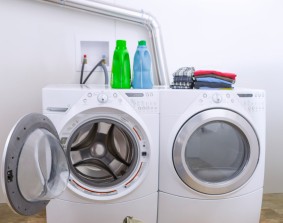by Doug Bonderud, http://www.angieslist.com/articles/4-laundry-room-renovation-mistakes-avoid.htm
Whether you’re putting in a washer and dryer upstairs, increasing the size of an existing room or simply just replacing old appliances, a laundry room renovation can result in a great return on investment.
But, tackling a project like this can still come with a caveat: Unexpected problems can bust your budget. Here are four of the most common (and troublesome) issues.
Poor drain placement
The biggest issue you’ll face with any laundry reno is water. If the washer drain overflows from a clog, machine failure or cold temperatures, you have a problem. Since this is very common, contractors can build in floor drains to carry excess water into your pipes and back outside where it belongs.
Before you start any renovations, check the slope of your floor and make sure it heads for the drain. A level floor will hold water, whereas one that slopes away from the drain can cause damage to walls, subfloors and ceilings. If you’re doing demolition, changing the configuration of the washer and dryer or putting in a new floor surface, check the slope before you re-install the appliances. If it’s wrong, start again or call a reputable contractor to give you a hand.
Missing your water shutoff valve
Water is also at the heart of the next problem. If your washer springs a leak or won’t stop running, you need immediate access to the shutoff valve. Often, you’ll find this behind the washer which may require reaching over the machine and twisting at an odd angle.
Ideally, you want the shutoff close at hand: high enough that children can’t accidentally turn it on or off, but accessible enough that you don’t have go searching in the event of a breakdown. If you’re tearing up the laundry space and can’t find the shutoff, you may need to open up the walls and see exactly what your plumbing looks like. Again, you might want to call in a pro.
Improper air ventilation
This room also needs ventilation, not just for your washing machine but for your dryer as well. Most laundry rooms are located along an outside wall in your home, allowing easy access for a dryer run and vent. Still, some builders skip installing vents for washing machines, especially if the “room” is actually at the end of a hallway or located in a mud room.
If you’re redoing the laundry space, adding a vent is your best bet, especially if you’re moving the washer and dryer to their own space. Hot water and high spin speeds can generate significant amounts of humidity, especially if a washer is running all day or if it isn’t properly sealed. No vent in the room means moisture on the walls, which eventually leads to mold.
No space for storage
Even rooms with all the right safety features can suffer if they’re too small. Before starting any reno project, consider how you’re going to build storage into the laundry room and other features that might come in handy. For example, front-loading washers and dryers are available with undermount storage, and a built-in shelving unit can offer a convenient space to store laundry soap, fabric softeners and other tools.
Since you’re dealing with water, a laundry sink is also a great addition if you can afford the cost: expect anywhere from $500-$750 for materials and labor. A washer, dryer and wire rack won’t be enough space or storage for long-term use so be sure to think about counters, sinks and other add-ons that can increase value without significantly adding to your budget.
